Spinning Arctic Waters
Air Date: Week of December 15, 2017
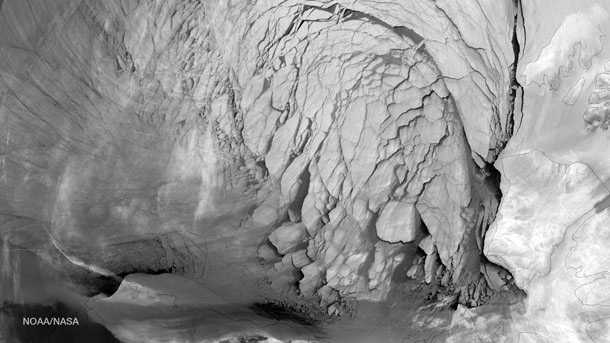
Early ice breakup in the Beaufort Sea in April 2016, driven by the Beaufort Gyre. (Photo: NOAA/NASA)
In the Beaufort Sea north of Alaska and Canada, a massive, 60-mile-diameter pool of cold, fresh water and sea ice spins clockwise to the tune of the Arctic winds. The Beaufort Gyre is a natural phenomenon, but something has gone awry with the way it operates, since its periodic reversal is way overdue. Canadian journalist Ed Struzik tells Host Steve Curwood why climate disruption is likely the culprit behind this gyre getting “stuck,” and why its eventual reversal could send chilly water straight to western Europe, plunging it into brutal winters and disrupting fisheries.
Transcript
CURWOOD: It’s Living on Earth, I’m Steve Curwood. The Arctic Ocean off Northern Alaska is called the Beaufort Sea, where a current known as the Beaufort Gyre circulates the waters and ordinarily changes directions every five to seven years or so.
It’s important because when this ocean current spins clockwise as seen from above, it traps Arctic ice and freshwater melt. When it spins the other way, it ejects that ice and fresh water out past Greenland into the North Atlantic, making weather in Northern Europe cooler. But in recent years the Arctic has been warming faster than the rest of the planet and perhaps as a result, the Beaufort Gyre has been stuck in a clockwise direction for a dozen or more years, spinning faster and faster, all the while collecting more and more ice and gobs of cold fresh water.
So, when the Beaufort Gyre finally does flip and flushes all that ice and cold water past places such as Iceland, Ireland and the UK, those places could be in for some brutal winters until it snaps back. Journalist Ed Struzik wrote about the climate implications of the Beaufort Gyre for Yale Environment 360, and for his explanation I called him up in Edmonton, Alberta. Ed, welcome to Living on Earth.
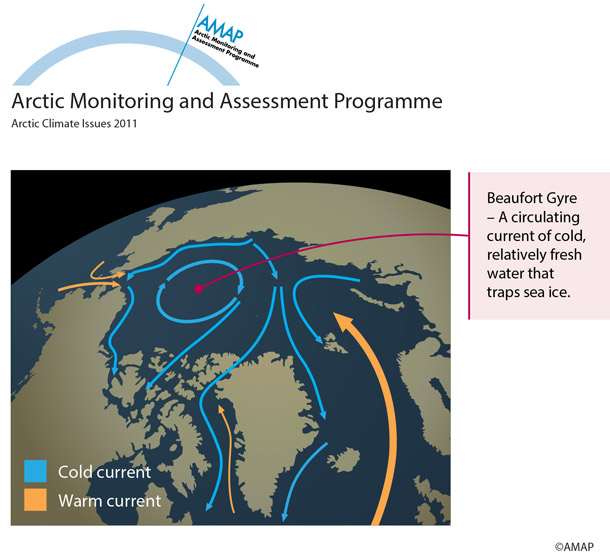
The Beaufort Gyre. (Image: AMAP (Arctic Monitoring and Assessment Programme), 2012. Arctic Climate Issues 2011: Changes in Arctic Snow, Water, Ice and Permafrost)
STRUZIK: Thanks for having me on.
CURWOOD: So, first explain to me what is the Beaufort gyre and what does it normally do?
STRUZIK: The Beaufort gyre is this huge swirling ocean current in the Arctic just above Alaska in the Yukon Territory, and it turns clockwise. It's generated by the winds, the polar winds that blow, and it keeps turning it clockwise. And what this thing does is it captures all of the cold, fresh water that comes from Arctic rivers and from melting sea ice and also sea ice, and it just traps it there and it rotates it and it continues to rotate it. And so, in the past the ice tends to grow, that freshwater grows, but every five to seven years you get these erratic storms in the North Atlantic that move into the Arctic and then it causes the gyre to weaken and then turns direction, and then it spits out all of those icebergs, all of that ice and all of that freshwater into the North Atlantic. And if it's a large enough amount as it was in 1960s and 70s, it can really significantly cool that part of the world.
CURWOOD: So, where is this gyre exactly? Is it circumpolar, does it go around the North Pole or is it sort of off to one side or the other?
STRUZIK: No no, it's quite a ways south of the North Pole. It would be in what's called the Beaufort Sea, north of Alaska and the Yukon Territory, maybe centered, you know, around 75 degrees north, and it's about … think of a big fly wheel – a 60 miles in diameter. And this thing just spins around like a fly wheel and it just gathers up all of that fresh water and ice and it just traps it, and it's actually higher because as more that spins it elevates all of that water in that part of the world just a wee bit higher and it's like a top, and it just traps it there until it spits it out at some point along the way, and some-some of these pieces of ice can sit there be trapped there for four years.

Icebergs in Otto Fjord, in the Canadian Arctic Archipelago adjacent to the Beaufort Gyre. (Photo: Ed Struzik)
CURWOOD: So, what's unusual about how the gyre has been operating in recent years?
STRUZIK: Well, it's no longer spitting it out every five to seven years. They've been waiting for almost 20 years for this to happen, and nobody really understands what's going on but it's probably a combination of climate change and massive runoff of freshwater coming off the Greenland glacier, which is preventing these big cyclones from forming over the North Atlantic and moving into the Arctic. So, this thing just keeps getting bigger and it spins faster and it collects more water. So, imagine all of the water that we have in the Great Lakes right now, that's the amount of fresh water we have that is trapped in the Arctic just waiting to get out.
CURWOOD: OK, you've been waiting for some 15, 20 years, whatever, for this to happen. When could this switch in the direction of the sea ice movement happen?
STRUZIK: Well, there's some signals that it could happen sooner rather than later, but they also thought that in 2013 when it appeared that things were weakening. It's going to happen at some point, and I think what everybody is watching for now, people from NASA, from Woods Hole, from the Ocean Science Institute in Canada is how much of that fresh water is it going to expel into the North Atlantic, because there's so much of it now, it's kind of unprecedented in modern-day history, and you know they're waiting for baited breath. It's not going to be The Day After Tomorrow, where suddenly everything goes into a deep freeze, but it's definitely going to have a chill on that part of the world.
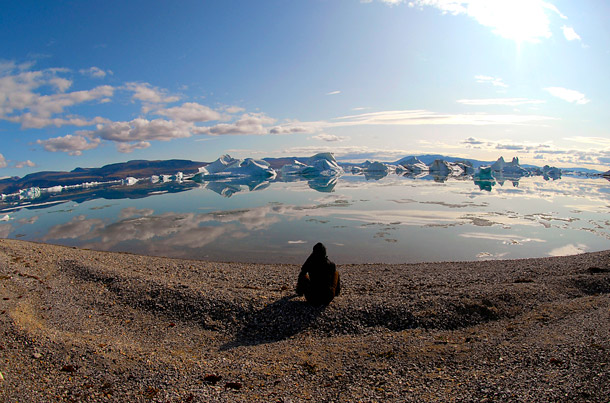
Panorama of Otto Fjord. (Photo: Ed Struzik)
CURWOOD: So, talk to me about why scientists think that when this switch does happen it could cool the climate of Europe, I guess, temporarily, and change things in the North Atlantic?
STRUZIK: Well, it because, I would liken it to a tsunami of cold water that's trapped, and it goes into the currents and it just flushes into a relatively warm, salty ocean. It creates a cap on that warm salty water and so that warps that you get in the North Atlantic coming from the Gulf Stream. That's why Iceland is so warm, and Norway is so warm, and England is so warm. You know, if they're the same latitude as North America, they'd have the winters like we had 10, 20 years ago. That's probably what's going to happen if it's big enough, and I think everyone agrees that it's big enough but it's just confounded scientists so much right now that nobody really wants to make a prediction at this stage.
CURWOOD: Now, I understand that in the late 1960s or the early 1970s, this happened, this dumping of the vast amounts of fresh water. What did it do back then?
STRUZIK: Well, think about all of that phytoplankton, zooplankton, those microscopic animals and plants that live on the surface, that the Arctic cod and Arctic herring feed on, they just went into shock, and it destroyed the food chain and so the herring fishery completely collapsed. People didn't know what was going on at that time, except the fact that the Icelanders suddenly woke up to ice on their north coast, which they don't normally get. And it didn't recover and we had another pulse of this water coming through in the 1990s, a smaller pulse. Scientists think that was that cold water that prevented the recovery of the cod fishery that collapsed as a result of over-harvesting. So, this has all kinds of potentially different impacts on both the ecosystem and on atmosphere climate.

The North Atlantic Cold Blob, seen in this image as a blue temperature anomaly from historic averages. Most of the rest of the Earth shows temperatures warmer than the 1951-80 baseline average. (Photo: NASA Goddard Space Flight Center)
CURWOOD: And what was it like in Europe at that big event in the late 60s and early 70s. What were some of the weather observations during that period of time?
STRUZIK: Well, Western Europe went through eight of its most severe winters during the height of that expulsion of water. They got a lot of snow, they got a longer than normal winter. So, they really felt the effects of it. And they're probably going to feel the effects of it again down the road.
CURWOOD: What kinds of implications could this have for the weather systems here in North America?
STRUZIK: Well, you know, it's a guestimate at this point. But hypothetically, if we have this warming of the gyre if that continues in the future and you lose all that sea ice, what may and what appears to be happening is that it grabs the jet stream and it sort of holds it up there and it creates this loopiness. It stops that dragging of weather across North America that we used to have fairly consistently, and it will hold those weather patterns and sometimes bring the Arctic air a lot further down south as we saw recently in Corpus Christi which got two or three or four inches of snow just a couple of weeks ago.
It's that kind of event you know, that it just disrupts that flow of the jet stream so and creates a lot more extreme weather in places where you don't expect extreme weather, and I think that that's likely what's happening and we're going to see more of in the future, but then again we really don't know because this is sort of an emerging science that everybody's trying to study and everybody's figuring out. We've really got to understand what this Beaufort Grye is doing, what La Niña and El Niño is doing, and right now there is this North Atlantic cold blob that they talk about that no one really knows what it's doing, how it may affect fisheries, and how it may effect climate, but it's sitting out there.
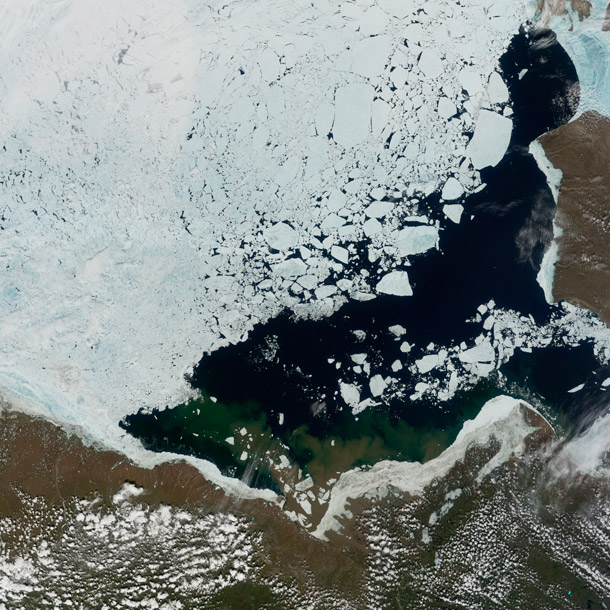
Sea ice retreat in the Beaufort Sea was especially rapid in June 2012, when NASA’s Terra satellite captured this image. (Image: Jesse Allen / NASA Earth Observatory)
CURWOOD: You mentioned the North American cold blob. What is that? And where is it?
STRUZIK: Oh, it's the North Atlantic cold blob, they call it. It's sitting, I think, in between the southwest corner of Greenland and northern Canada and if you look at it, I think, maybe NASA and Woods Hole may have a map which shows just this big cold spot sitting in the North Atlantic. Everybody's been watching it. I don't know if you've heard about the warm blob that's been in the North Pacific, that many scientists think accounted for the death of a lot of birds in that part of the world because it also affected the food chain, but we tend to have these blobs that are carried by currents, and we really don't understand how they form, what the impact is on the ocean, but they're there and everybody's watching them with great anticipation.
CURWOOD: Ed, how does the El Niño, La Niña phenomenon relate to this Beaufort gyre?
STRUZIK: It doesn't really relate. It's basically this similar kind of phenomenon, you know, that it's a warming of the Pacific Ocean, a cooling of Pacific Ocean that we know has affect on drought and rainfall in different parts of North America and all around the world. And this is really a kind of a northern El Niño, La Niña type situation. It is a huge ocean current that tends to swirl one way for long periods of time and then reverses and it has a dramatic impact on climate. In this case, climate change appears to be having a profound impact on this plumbing system that we have in the Arctic. We kind of know La Niña has been a little bit more predictable than the El Niño events, and we just don't know enough about this Beaufort gyre to be able to say one way or the other how it's going to affect our future.
CURWOOD: So, Ed you've been writing about the Arctic for 30, 40 years. What changes have you seen while reporting from there over these decades?
STRUZIK: Just an enormous number of changes. You know, it used to be that you went up to the Arctic and it was all sunny skies because you had this you know you had so much ice reflecting all that warmth from the sun back up that these high pressure systems that come in from Siberia just sort of hung in there. And so summers were generally kind of pleasant. They might be a little bit chillier. Now we have a lot of fog, a lot of cloud, and increasingly more cyclonic activities. We had this huge knock ’em down storm that came through the Arctic in 2012 – and I was actually in a small sailboat at the time - that just rocked the Arctic. I mean it broke up sea ice like a bulldozer, you know plowing through a field. It was astonishing to watch. A lot of scientists kept their eye on that one.
CURWOOD: You know, in recent years, the commercial shipping interests have been rubbing their hands together saying, “There's a northwest passage and we can use the Arctic Ocean as a way to get from one side of the world to the next.” But if they're going to be these horrific storms that we haven't seen in the past, how wise do you think that is?
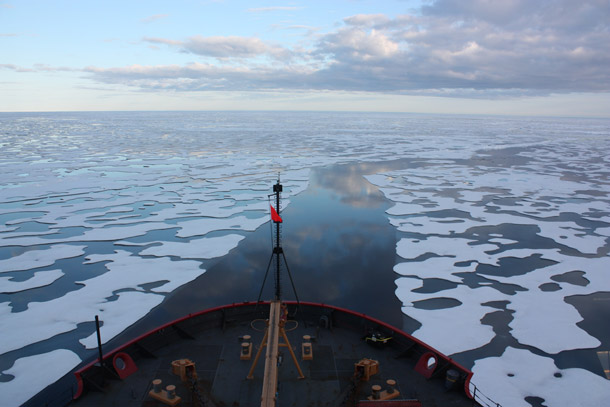
Arctic sea ice is thinning year after year. (Photo: NASA/Kathryn Hansen)
STRUZIK: I think the bigger problem for the shipping companies right now is that the Arctic between Alaska and Europe is really not well mapped out, and also it's a fairly narrow shallow strait, and this is the biological hotspot of the Arctic. You've got Polar bears, narwhal, Beluga whales Bowhead whales, you know, that gravitate towards these places and having ships pounding through the ice or through those waters at the time of year when all of these whales are migrating through you know I think is really really the big issue right now. They can get through, there's no question about it, but I think that we really have to consider what impact it's going to have on the ecology of that area.
CURWOOD: Ed, remind us just how much warming has been going on in the Arctic over these last 50 years, and Greenland as well.
STRUZIK: Well, the Arctic is the fastest warming place on the Earth, and Greenland right now, I think, it's 256 billion tons of ice has melted off that ice cap each year, that summer ice that we saw, you know, holding in persistently in places like the northwest passage are disappearing, and what is also happening is that we have southern species now starting to move north into those warmer waters. So, you're starting to see Killer whales starting to kill narwhal and beluga whales. People never saw Killer whales in the Arctic before. You're starting to see Pacific salmon into the eastern Arctic of Canada. In fact, the first Pacific salmon in Greenland was caught there just a few years ago.
So, the changes that are occurring are really dramatic. We're heading towards a seasonally ice-free season in the Arctic and we haven't seen that in our recorded history anyway. The 500-year search for a northwest passage was doomed because there is way too much ice in the Arctic, and now it's like I said, I was in a 46-foot sailboat sailing through the passage in 2012, and we got a lot of wind but we are hardly saw any ice.
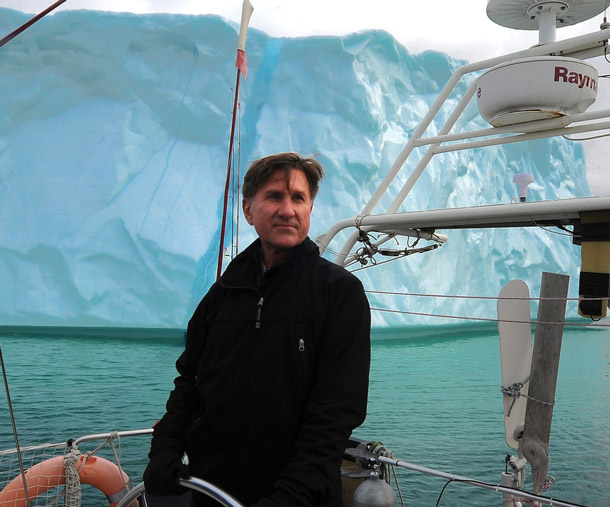
Canadian author and photographer Ed Struzik has been writing about the Arctic for three decades. (Photo: Ed Struzik)
CURWOOD: Wait a second. Here we are at the holiday season in North America and you're telling me that Father Christmas, that Santa Claus is set up on the North Pole, I mean there's no there's no place for him anymore huh?
STRUZIK: Well, you know, I think you know that's probably the message is that he's probably instead of a sled it's going to be a sailboat and maybe a flying sailboat that he's going to use in the future because at some point in time, maybe not December, but there has been open water at the North Pole in December in the past. Not a lot of it, but we're moving in that direction so if I were a meteorologist, I would just advising Santa, I'd suggest that maybe he changes transportation systems.
CURWOOD: [LAUGHS] Ed Struzik is a fellow with the Institute for Energy and Environmental Policy at Queens University and author of “Future Arctic: Field Notes from a World on the Edge.” Thanks so much for taking the time with me today.
STRUZIK: Oh, thank you very much. It was a pleasure.
Links
Yale Environment 360: “How a Wayward Arctic Current Could Cool the Climate in Europe”
Ed Struzik is the author of Future Arctic: Field Notes from a World on the Edge
Living on Earth wants to hear from you!
Living on Earth
62 Calef Highway, Suite 212
Lee, NH 03861
Telephone: 617-287-4121
E-mail: comments@loe.org
Newsletter [Click here]
Donate to Living on Earth!
Living on Earth is an independent media program and relies entirely on contributions from listeners and institutions supporting public service. Please donate now to preserve an independent environmental voice.
NewsletterLiving on Earth offers a weekly delivery of the show's rundown to your mailbox. Sign up for our newsletter today!
 Sailors For The Sea: Be the change you want to sea.
Sailors For The Sea: Be the change you want to sea.
 The Grantham Foundation for the Protection of the Environment: Committed to protecting and improving the health of the global environment.
The Grantham Foundation for the Protection of the Environment: Committed to protecting and improving the health of the global environment.
 Contribute to Living on Earth and receive, as our gift to you, an archival print of one of Mark Seth Lender's extraordinary wildlife photographs. Follow the link to see Mark's current collection of photographs.
Contribute to Living on Earth and receive, as our gift to you, an archival print of one of Mark Seth Lender's extraordinary wildlife photographs. Follow the link to see Mark's current collection of photographs.
 Buy a signed copy of Mark Seth Lender's book Smeagull the Seagull & support Living on Earth
Buy a signed copy of Mark Seth Lender's book Smeagull the Seagull & support Living on Earth

